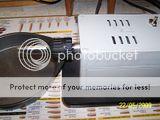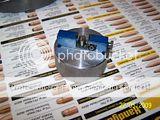Trickymissfit
Well-Known Member
You've got some pretty weird notions Gary..
For one, neck turning has nothing to do with adjusting either concentricity or runout.
It's purpose is soley to produce necks at a desired thickness. Fireforming takes care of the rest.
Neck turning is a floating operation with the turner in hand. So even though wobbly cases are less fun to turn, thickness results hold well.
Pin anvils will not work so well for items of tapered thickness, or irregular form. This is often what you have with new brass.
A ball provides a precise point contact, which is all we desire to read -at each point.
I don't think I could stand the Pumpkin because it looks to obscure observation of the cut. And I really dont see a 'system' there.
Just a turning tool. Don't know about mandrel/expander or cutter options, and everybody knows indicators don't work for measuring neck thickness..
Now all turning tools have complete adjustability with their cutters. I'm sure the Pumpkin does as well. But it doesn't matter if you commision NASA to provide 1/2thou cutter clicks. You still have to turn a case or two to determine that needed adjustment. It's trial & error because results vary by the amount taken in the pass.
Within 4 culled cases I can adjust ANY turner to the correct results using feeler gauges and the cutter set screw to lock it down.
But it's my understanding that the Pumpkin uses an eccentric mandrel for adjustment. So does Sinclair's NT4000 in a sense(eccentric mandrel collar).
But Sinclair still retains a round mandrel, which is useful elsewhere. Sinclair is large enough for cooling and to hold steady, and it's unobstructed which aids in controlling the feed rate.
I Don't like the K&M because their mandrels are too big for use beyond turning, and the expandiron is nothing but a button(the first thing to remove from a die, and throw away) which wipes shoulder brass into necks and pulls necks all outta whack. It's body was too small for me. The inside reamer is not needed or desired for turning. It's purpose is specifically to grind out doughnuts(if you have that issue). But beyond my nit-picks, it does work well. Just no better than Sinclair's more useful system.
You know,, everyone supports what they have.
And this is one subject I need to start steering clear of.........
what you've stated in your post parallels my thoughts exactly! I do not like neck turners that follow a mandrel. If you have clearence between the mandrel and the neck wall you have error. This is why I'm so interested in the Wilson neck turning setup, as everything is located off of the centerline of the case body instead of the neck centerline. (make sense to you?) But I have not bought the setup yet, but I will.
I have found that a once fired case will have some runout in the neck on every rifle I own. Of course some are a little more than others, and I do have a couple rifles that will be less than .0005" everytime. Probably good enough for 98% of the shooters on this planet. Now I do not neck size every round I shoot, but the smaller sizes I do. I like to size the I.D.'s before I do anything else. When I do this they are to the size I want, and then I base everything off that. Sinclair wants you to actually expand the I.D. for clearence, and I'm dead set against this. You have to have a good starting point to gauge everything off of.
I neck turn for two basic reasons. One is to fit the chamber, and the other is to improve concentricity. The latter works well for me, but it's also not perfect. I often see brand new brass with as much as .010" runout in the neck (usually junk), and .005" is common. If I full length size a case; hopefulling the I.D. of the neck is in correct relationship with the centerline of the body of the case. That's when it's time to shave the necks. If I don't do this and size with a bushing it throws the I.D. out of alignment. I basicly shave the necks to make them concentric with the I.D. Works well for me. Are my loaded rounds perfect? Far from it! But I do see a vast improvement on my runout gauge. Now there's nobody here that hates neck turning any worse than me, and if there was a better way I'd jump on it.
The Sinclair tool can be made to work well, but I still don't like it. I've experimented with diamond shaped arbors, and they are better (less friction buildup). Their cutter leaves a lot to be desired (a Devlieg cutter would be perfect). Still I can do a couple hundred rounds of brass and hold the O.D. to less than .0003" with a diameter window of about the same. Still I have always found it to be awkward to use. Not perfect, but I'm trying! Also I think I've reached the point that I need a better way to seat bullets. .0005" error here gives you .001" TIR on a loaded round. I'm working on a new seater die design that I hope will cure at least 50% of the rest of the run out. But to use it will be a four step operation; thus being a little slow in the process. Of course the otherside of the coin flip will say just how good do you really need?
In my world I've always found that measurments came out better when measured over pins. The only time I ever relied of balls was to locate something. If you have access to a pin mic that you can change the anvils in; try it. I use gauge pins as they are more ridgid. But if a ball mic works for you, then so be it. But the pins will mimic the seating area of a bullet, and that's the critical point in the end.
gary
Last edited:


